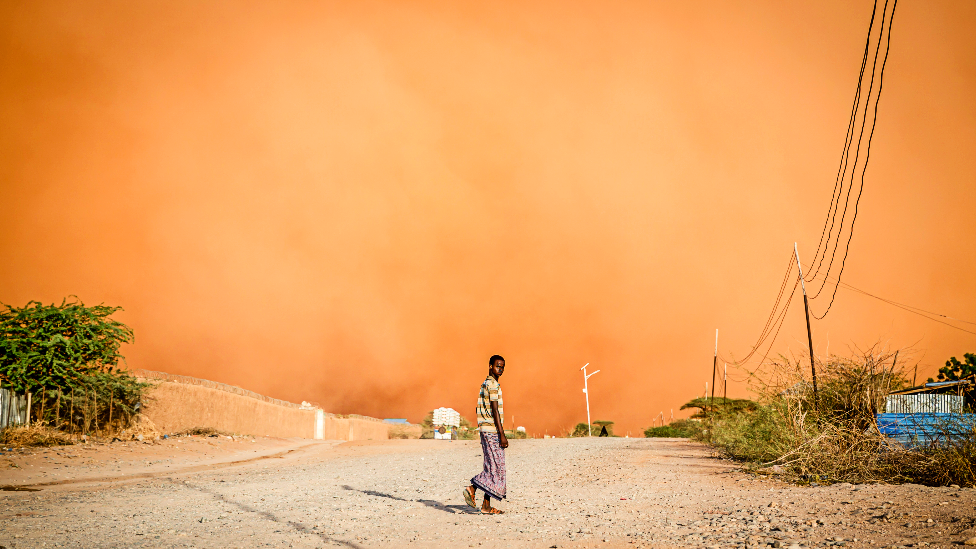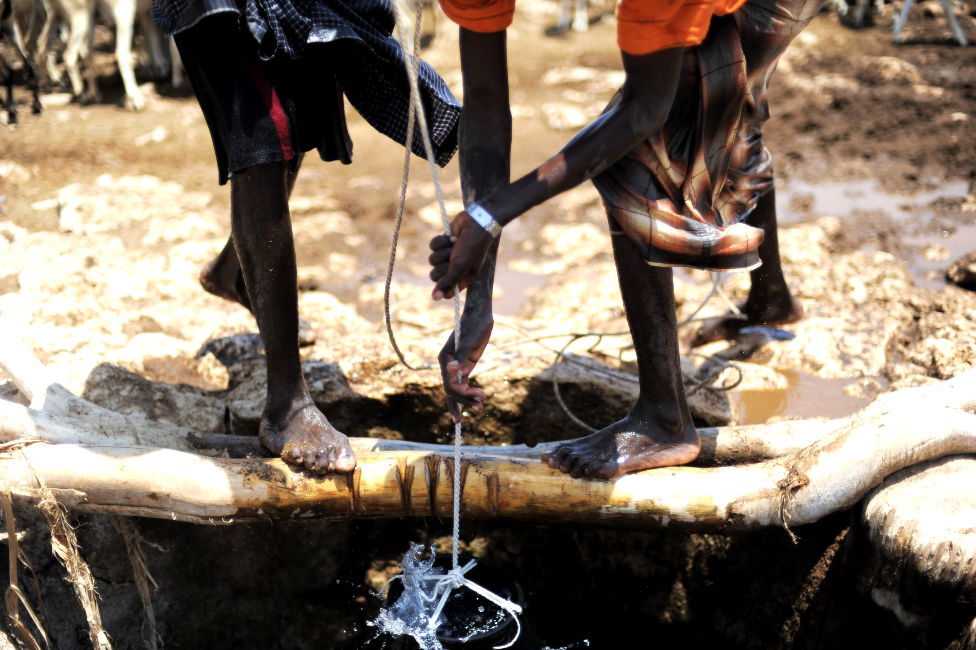Somalia’s men in sarongs taking on al-Shabab militants
- Published

Some unlikely fighters are strengthening the Somali government's arsenal in its long war against al-Shabab, one of al-Qaeda's most successful affiliates - and which was behind a twin car bomb explosion in the capital, Mogadishu, last weekend that killed at least 120 people.

Images of men in sarongs and flip-flops running about with guns are one of the most enduring stereotypes of conflict in Somalia.
Footage of these be-skirted fighters careering through smashed-up cities, firing wildly as they go, is shown again and again, much to the annoyance of Somalis who say this is not a fair or accurate representation of their society.
Somalis call these sarongs "ma'awiis". They usually come in muted colours, decorated with abstract designs originating in Indonesia.
Many men use them as everyday wear, while others put them on to relax in the evenings or to recline more comfortably while chewing the narcotic leaf khat.
Now men in sarongs, or "ma'awiisley", have become a powerful new weapon in the battle to bring an end to the country's 15-year Islamist insurgency.
These groups of clan fighters have sprung largely from nomadic and farming communities living under al-Shabab, which controls vast swathes of territory in southern and central Somalia and imposes strict rules on those who live there.

As drought bites, people cannot afford to pay al-Shabab taxes
Although the Islamist militants have a powerful network of spies who monitor every aspect of people's lives and punish severely those who disobey, a grassroots movement has risen up against them.
As the worst drought in 40 years takes hold and famine creeps ever closer, people can no longer afford to pay taxes to al-Shabab.
With more than three million heads of livestock perishing from lack of food and water, they can no longer hand over animals demanded by the militants.
They can no longer bear to hand over their sons and daughters to serve as cannon fodder and sex slaves. They have simply had enough.
Small groups of nomads and farmers have periodically risen up against al-Shabab in recent years, only to be crushed mercilessly.
This time the ma'awiisley militias are larger and more co-ordinated, and are provided with ammunition, food and fuel by the government.
Security analysts say some of them are rehatted members of the Somali National Army.
"The insurgents are now facing an insurgency of their own," says Mohamed Mubarak, chairman of the Mogadishu-based Hiraal security think-tank.
"If this spreads nationwide, I don't think al-Shabab will survive."
'We have no fear'
The jihadists' reaction to the ma'awiisley shows how seriously they are taking them.
They have embarked on a spree of burning homes, destroying wells and killing business people and elders who belong to the same clans as the ma'awiisley fighters.

Wells are essential for nomads who pull up the water for their animals to drink
In a recent speech to graduates of al-Shabab training camps, its spokesman Sheikh Ali Dheere described the ma'awiisley as "the robbers and rapists that roamed the country before al-Shabab came to power".
But Musa Idris Hassan, a member of a ma'awiisley militia in central Somalia's Hiran region, disputes this.
"We are nomads. We have always been warriors. We have lived under the militants for years so we know everything about them including where they hide.
"We will crawl into every bush to find and slaughter them all. We have no fear of al-Shabab or anyone else."
I have never seen the international community so excited about the war against al-Shabab"

The ma'awiisley are not acting alone. They form a crucial part of the government's new strategy to fight al-Shabab, which includes US airpower, African Union (AU) soldiers, foreign-trained Somali elite forces, the national army and troops from the country's five federal states.
"I have never seen the international community so excited about the war against al-Shabab," says the architect of this new approach, National Security Adviser Hussein Sheikh-Ali.
"The ma'awiisley are a key addition to the battlefield. They give legitimacy to our war against the militants because they come from the communities they control.
"They play an essential support role by providing the intelligence which enables our special forces to go in and smash the insurgents. We are now on the road to defeating al-Shabab completely."
Amina Musa lived for 13 years under the control of al-Shabab in the central town of Booco, which was taken back by the government in September.
"The ma'awiisley are much better than the army," she says. "They fight from their hearts not their stomachs.
"They are more motivated because their lives have been directly affected by the Islamists, who have stolen their children, their animals and everything that is good about nomadic life. Their anger is real."
The addition of local clan militias to what Somalia's President Hassan Sheikh Mohamud has described as "the total war" against al-Shabab has made a difference on the ground.
Security experts say Somalia has recovered more territory between June and September than it did in the last five years.
Clan war dangers
But beating back al-Shabab is not enough. The challenge is to hold territory.
The militants have a long history of staging tactical withdrawals then marching straight back in once the army and AU troops move on.
This strategy will only work if the ma'awiisley are disarmed or subsumed into the regular security forces after areas are recovered"

If the government is to succeed in its "total war", it will need to replace al-Shabab's far-reaching governance structures and social services, including police forces, courts, taxation systems, schools and health facilities.
According to Mr Mubarak, the authorities will also need to work out what to do with the ma'awiisley, who he warns could turn out to be a poisoned chalice.
"This strategy will only work if the ma'awiisley are disarmed or subsumed into the regular security forces after areas are recovered and their local issues solved before launching liberation operations, especially in areas with existing local conflicts," the Hiraal security expert says.
"Otherwise, Somalia risks being confronted by the new danger of having clan militias armed to the teeth and turning on each other. This could take us back to the clan wars of the 1990s."
The recent gains against al-Shabab suggest the current cocktail of international, regional, formal and informal Somali forces is working on the military front.
Dozens of towns and villages have been seized in recent weeks. Combined with the government's efforts to disrupt financial flows to the militants and challenge their ideology, this could be the answer to weakening the movement significantly, if not defeating it entirely.
More on al-Shabab and the drought: